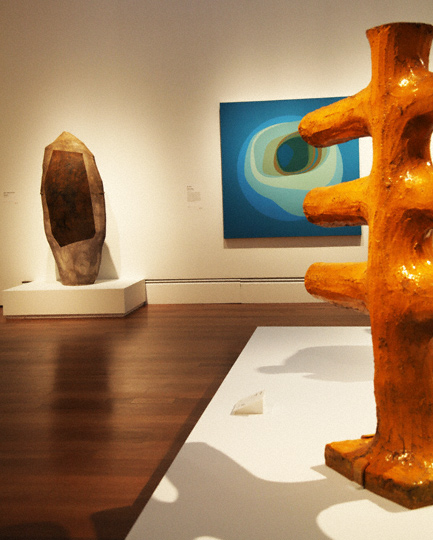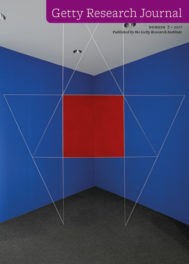
Inside Crosscurrents: Helen Lundeberg’s canvas Blue Planet, 1965 (© Feitelson Arts Foundation, courtesy Louis Stern Fine Arts) with, at left, John Mason’s Vertical Sculpture, Spear Form, 1957 (Aichi Prefectural Ceramic Museum. © John Mason) and, at right, his Orange Cross, 1963 (© John Mason)
In the ocean, a crosscurrent runs across the main flow, stirring things up. Similarly, you can see different artistic movements, crossing each other from a variety of directions, in the exhibition Pacific Standard Time: Crosscurrents in L.A. Painting and Sculpture, 1950–1970, which opens Saturday at the Getty Center.
The exhibition features more than 70 objects by over 45 artists and explores the beginnings of important artistic movements that developed in Los Angeles, as well as the diversity in artistic practices that characterizes the postwar L.A. art scene. Here’s a preview of what you can experience.
Centering on movements that began in the early 1950s, the first gallery features human scale hand-built clay sculptures by John Mason and Peter Voulkos, surrounded by hard-edge abstract paintings such as Karl Benjamin’s bright geometric painting Stage II from 1958 and Helen Lundeberg’s striking Blue Planet from 1965.
These two distinct movements, ceramic sculpture and hard-edge painting, are rarely exhibited together, but in Los Angeles, this work was happening at the same time. Many of these artists knew each other—and seeing the works together, it’s easy to imagine that their use of color and form influenced one another.
Moving to the next section of the exhibition, you’ll experience assemblage sculpture and collage, with work from major figures who pioneered these approaches in the 1950s, such as George Herms and Wallace Berman. Herms’s important sculpture The Librarian (1966) is assembled from a wooden box, a painted stool, photos, papers, and books; in the 1960s, Betye Saar blended her renowned printmaking skills with assemblage and collage to create intricate works such as The Phrenologer’s Window.
As Los Angeles rose to international prominence as an art center, artists increasingly began to address the city itself—its landscape, culture, and art scene—in their work. In the next room of the exhibition, you’ll see Vija Celmins’s use of her commute on the 405 as a subject for a 1966 painting juxtaposed with Ed Keinholz’s assemblage portrait of gallerist and curator Walter Hopps. The cubbyholes and compartments on the back of the life-size tribute bear witty labels such as “New York artists I want to show” and “competitors and other uninformed types” and will be left open in varying combinations throughout the run of the exhibition.
Moving now into a particularly immersive room of the exhibition, you’ll encounter large paintings by some of L.A.’s most celebrated artists. Here you’ll see two very different paintings from John Altoon and Richard Diebenkorn, each taken from the artists’ respective “Ocean Park series” and painted while each artist was living and working in the Santa Monica neighborhood—Altoon in the ‘60s, Diebenkorn in the ‘70s.
In this same room, David Hockney’s depictions of domestic life in Los Angeles are juxtaposed with Ed Ruscha’s cinematic The Los Angeles County Museum on Fire from 1965–68 and Standard Station, Amarillo, Texas from 1963.
Turning left into the final section of the exhibition, you can discover the ways artists were beginning to expand the notions of painting and sculpture at the same moment West Coast painting was gaining international prominence.

Inside Crosscurrents: De Wain Valentine’s Red Concave Circle, 1970 (Bank of America Collection. © De Wain Valentine) with, at left, Norman Zammitt’s North Wall, 1976 (Collection of Leon Gazarian & Monique Powell. © Norman Zammitt Estate) and, at right, Mary Corse’s Untitled (White Light Grid Series-V), 1969 (Andrea Nasher Collection. Permission courtesy Ace Gallery and the artist)
Sculptures that foreground perceptual phenomena are installed here alongside works that emphasize process. A poured resin piece by Peter Alexander and an acrylic-and-resin-on-canvas painting by Ed Moses retain traces of their creation, highlighting the artistic process over the finished effect. Yet they resonate powerfully with works that emphasize surface and visual perception such as Judy Chicago’s sprayed acrylic Big Blue Pink from 1971 or Larry Bell’s untitled wall piece, which uses strips of reflective black and white glass to create the illusion of a disappearing wall.
You’ll also encounter De Wain Valentine’s massive Red Concave Circle from 1970, an eight-foot resin disc that draws you in as you move around it. The highly polished piece reflects the bright orange, yellow, and black lines in Norman Zammitt’s 1976 painting North Wall.
And in a 1969 painting from Mary Corse, White Light Grid Series-V, thousands of tiny glass “microspheres” reflect the light and subtly pick up the orange and red hues of the Valentine and Zammitt pieces.
To finish your tour, try revisiting the galleries from the top one more time (or even returning through your tour, in reverse order). You’ll see more crosscurrents, and more connections, the longer you look.




This looks like a fantastic exhibition. All this beautiful Los Angeles art in one place is a dream come true.